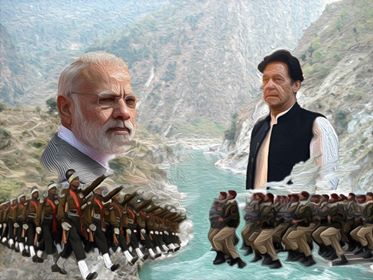
Image: Matt Brafman
By Samuel Leiter
India and Pakistan have a long history of conflict over the contested borders in Kashmir, but that conflict has become noticeably more belligerent since the Bharatiya Janata Party (BJP) rose to power in 2014. Under Modi and BJP, India has pressed its advantage in relative power through continuous shelling along the Pakistan border as well as political encroachments such as its recent decision to remove special autonomy status from the provinces of Kashmir and Jammu. These actions have not gone unanswered by Pakistan, which has responded with commensurate military and diplomatic actions which have yet to succeed in deterring Indian encroachment. However, the most important development in recent years has been the increasing potential for India to control Pakistan’s supply of water.
Control over Kashmir holds both religious and political significance, but the region is also one of the most geostrategic for any country in the world. Kashmir (and Jammu) have majority Muslim populations in the majority Hindu country of India, which creates ethnic tensions that bolster Pakistan’s ability to claim the territory, but Pakistan’s primary concern with Indian control over Kashmir is not religion, but water. The Indus River and its tributaries provide Pakistan with its main source of water. That water begins in the Himalayas as snow melt and travels through the Indian provinces of Kashmir and Jammu before reaching Pakistan. Pakistan and India have agreed to share this water source under the 1960 Indus Water Treaty (IWT). The IWT guarantees Pakistan exclusive access to the three western rivers of the Indus system and India the three eastern, but Indian control over the Kashmir and Jammu means only it holds the power to restrict the other side’s access to water. The significance of the region to Pakistan’s security and survival is magnified by Pakistan’s dearth of water which has been compounded by climate change and led experts to predict Pakistan will face absolute water scarcity by 2025.
Although the IWT has been upheld since 1960, the Indian government’s recent use of salami tactics has intentionally put India in a position to cut off Pakistan’s water supply. India is building numerous dams throughout the region including one of the aforementioned three western rivers of the Indus system, violating the terms of the IWT. India has also shown it isn’t afraid to use water access as a tool for coercion or deterrence. When a suicide bomber from Jaiesh-e-Mohammed (a terrorist group with links to the Pakistani intelligence agency known as ISI) attacked an Indian paramilitary convoy this February, India retaliated by cutting off Pakistan’s supply of water from the eastern rivers of the Indus system. Though cutting off the water supply was completely within India’s rights—since the IWT recognizes those rivers as India’s—it signals that India is willing to use its leverage over Pakistan’s water as a weapon.
Pakistan has even more reason to be concerned about the possibility that India will use its leverage over Pakistan’s water supply now that it has revoked the Kashmir and Jammu’s special autonomous status, giving India greater control over government policy and administration. The loss of special autonomous status allows those who are not permanent residents of these provinces to hold government jobs and buy property. That means the majority Muslim population in these provinces may see its majority dissipate as India follows China’s example in Xinjiang by encouraging migration in order to shift the region’s demographics and allegiances. While it may not play out this way, the greater control of the region’s law, governance, and police forces will provide India with greater control over the region through which Pakistan’s water flows. This alone would not be too threatening to Pakistan’s security, but in conjunction with India’s recent dam construction and a demonstrated willingness to restrict access to water, Pakistan is no longer guaranteed resource security under the IWT.
India may not ever restrict Pakistan’s access to the three Western rivers, but in international politics countries tend to respond to capabilities and India is on its way to having that capability. Pakistan may attempt to stop India from restricting its water through military actions, terrorist attacks, or public statements, but India will certainly be operating from the position of strength. This bodes poorly for the future prospects of peace in the region and helps elucidate why many observers believe India and Pakistan are the most likely nuclear-armed states to go to war.

Samuel Leiter is currently an analyst at the Civic Consulting Alliance where he advises leaders in Chicago’s public sector on community policing and police reform. He graduated from the University of Chicago with a BA in Political Science in 2018 and received general and departmental honors for his thesis on the risks of nuclear proliferation. Sam is fluent in Japanese and is interested in the future of the US-Japanese alliance as the global order shifts. In his free time, Sam enjoys playing basketball, attending concerts, and exploring Chicago’s restaurant scene.


Leave a Reply